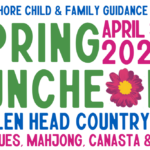From time to time, North Shore Child and Family Guidance Center has used animal assisted therapy (AAT) in its mental health treatment programs with children and teens, working in partnership with local canine and equine organizations.
In animal assisted groups, the therapist works closely with the animal handler or trainer. Think of the handler as an interpreter who teaches about the animal. The handler loves to talk about the personality of the animal and its unique qualities. They can humanize how the animals “speak” and keep appropriate boundaries.
Although using dogs is a little easier to arrange logistically speaking, there are a growing number of settings that offer equine facilitated therapy. Following is an illustration of animal assisted therapy using horses that helped build social skills and self confidence in a group of young teenagers who were identified as painfully shy or socially awkward.
After they arrived at the stables, the girls and boys sat around a table. Group work with horses mostly entails ground activities. Sitting on or riding the horses is the exception.
The horses were led outside and the group members were asked, “How do the horses welcome each other? How did they say hi?” Or “Look at Rusty: he looks like he is trying to get away from the others. Why do you think that is?” This opened the door for humor, as one of the more quiet boys said, “Maybe he has B.O. or bad breath.”
The handler then said, “Oh, did you see that? Rusty tried to kick that horse. Why do you think he did that?” This led the way to some discussions about anger and aggression.
In time the process became a little more sophisticated—for example, when the teens were asked, “How do the horses communicate?” The group could see that horses are powerful animals. The handler taught them that horses are prey animals that are always on the lookout. They learned that these majestic animals are instinctual and that they don’t see straight ahead but side to side, thus the rule to always stay on their side. (And, similarly, when a group is working with canine therapy, they learn not to look a dog in the eye because he can take it as aggression.)
The handler said, “See, you stay on their side because horses look side to side to scan the horizon.” Later, they learned that approaching and petting animals is a lesson in respecting one’s boundaries.
It was all about observation and metaphor, helping the young people build their observational muscles and reflect on what they saw and sensed. The activities were both direct and yet metaphorical in nature.
After a while the group members were asked, “Which horse do you want to spend some time with and why?” One group member said, “I’ll take Rusty; he’s a little shy but I think he is a tough horse and nobody’s gonna mess with him.”
Some of the teens we work with are immigrants from Central America, who escaped treacherous circumstances, and being with the horses brought back fond memories and staked a little claim to fame for them in the group. For example, Maria shared, “I know something about this. My family has horses. That one over there looks sad.”
The handler then talked about the “sad” horse’s history. Many of the horses were adopted and/or donated. This piqued the kids’ interest as the horse’s experience became a metaphor for their own dislocations and transitions. These issues were explored in a subtle, sensitive manner whereby the participants could project their feelings and experiences on the horses in an emotionally safe way.
By working with horses or dogs, children and teens learn many lessons, among them the importance of expressing their emotions, the ability to bond (both with the animal and with the other kids) and ways to keep calm and decrease stress. It’s a profound experience that can have lasting positive effects.
Andrew Malekoff is the executive director of North Shore Child and Family Guidance Center, which provides comprehensive mental health services for children from birth through 24 and their families. To learn more about the Guidance Center’s innovative programs, call 516-626-1971 or visit www.northshorechildguidance.org.















